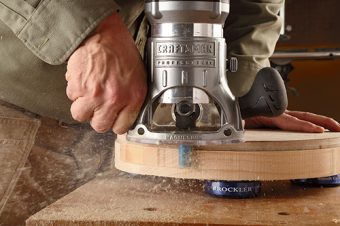What Does Router Horsepower Mean?
There's more than one way to measure horsepower, and some aren't a good indication of how a router will work in an actual woodworking situation. Manufacturers aren't all that likely to tell you which one they used, but most will supply a more useful measure: rated amperage. Even that isn't the perfect guide in selecting a router.
I am considering a router purchase, but I'm not sure what the numbers mean. Can you explain the merits and differences between amp ratings and HP ratings.
Ellis Walentine: Horsepower ratings on routers are only semi-useful, and only for comparison purposes. Common sense tells us that a 3 HP router doesn't have the same muscle as a 3 HP cabinet saw. Amp ratings are more objective, but they can't be taken as the final word on power either, since the amount of amperage a universal motor draws is affected by its efficiency and several other factors.
Oddly, when we built a dynamometer to test routers back in '93, we spent a month crunching numbers to try to figure out which measurements were actually useful to prospective buyers. We decided that the best indicator of power was RPMs under load. In other words, how well did the router maintain its speed under differing load conditions? We applied loads corresponding to light, medium and heavy cutting tasks and measured the draw-down in bit speed with a sophisticated stroboscopic tachometer. The gutsier motors showed only a small drop-off in speed, while the speeds of the weaker motors dropped precipitously, some by more than 65%.
Rated amperage is very useful for one thing: It's a good way to narrow the field. The type of router work you'll be doing will, of course, be the biggest influence on the amount of power you should look for in a router. If you need a router mainly for light-duty, handheld machining for inlay and whatnot, a king-sized 15 amp model might not be the best choice. And by the same token, a lightweight, easy to handle 10 amp or less router will turn out to be a disappointment if the plan is to whip out raised panels on a router table from 9 to 5.
Picking the best router from a group of likely suspects is a matter of further research. The best place to start is by learning more about how power tool motors work, and what makes a good one. Reading reviews and asking other woodworkers what worked out best for them is probably the best basis for a judgment. There's no shortage of discussions on woodworking forums about which routers live up to their manufacturers' claims.
Keep the inspiration coming!
Subscribe to our newsletter for more woodworking tips and tricks





